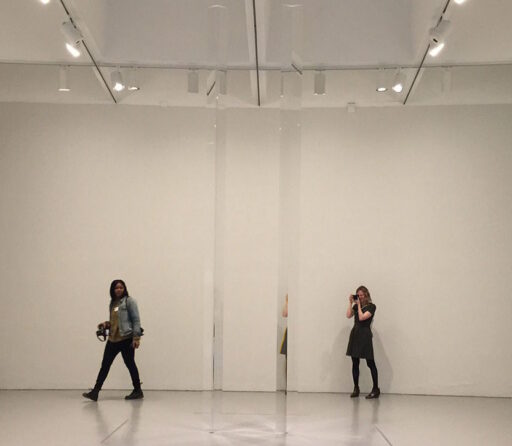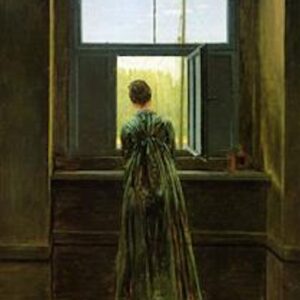Robert Irwin died a few months ago. He was 95 years old, so this was not a great tragedy. I didn’t know the man personally, but I have the sense that he lived a good and fulfilled life. He was quite famous within the more or less refined corners of the international artworld. He’ll probably always be most associated with the so-called Light and Space Movement that emerged in California, more properly southern California, in the late 1960s. Judy Chicago also did important works from within the Light and Space sensibility. James Turrell. Mary Corse. If these names mean anything to you. Quite fine if they don’t.
It is hard to describe the works of Robert Irwin. A typical work by Robert Irwin is, for instance, a piece called Untitled (Acrylic Column), which is generally listed as having the dates 1969-2011. I guess that’s because he kept making and remaking the piece over those years. It’s a simple work of art. Basically it’s a free-standing column of see-through acrylic about fifteen feet high. The column is constructed in a kind of ‘V’ shape so that it doesn’t fall over. Also, stuff happens with the light and with the refractions of vision in that shape.
Stuff happens. This is not the most helpful description, I know. But that’s what is interesting about the work. The stuff that happens in the room because the column is in the room. The column itself isn’t interesting at all. If you stand there, in the gallery or museum or wherever, and just look at the column you’ve completely missed the point. The column is there because of what it does, not what it is. And what the column does is to split the room up in visually startling ways. The column messes with the visual unity of the room. People walking behind the column suddenly disappear, or are sliced into various sections. Visually, of course. Not really. But then again, what is really?
The column makes something happen in the room. This is only possible because people, or I suppose other kinds of creatures too, but most essentially because people go into the room and then encounter the strange way that the column messes with one’s experience of the room, creating a kind of heightened sense of being in the room altogether. So the work Untitled (Acrylic Column) is really about experience. Or it simply is experience, since it isn’t exactly about anything in the normal sense that an artwork can be about something. The work doesn’t reference or represent or symbolize or anything like that. It just makes experience.
Philosophers, especially those of the Kantian extraction, sometimes like to talk about transcendentals. To make a long story short, transcendentals are conditions for the possibility of other things to be. Space and time, for instance, are transcendental because they are necessary conditions for there to be physical objects at all. An object, to be an object, has to be here or there at this or that time. You could say, then, that when you think transcendentally you are trying to go to the very roots of experience. What is there at the root? What underlies the possibility of experience altogether?
Interesting questions, philosophically. But Robert Irwin was an artist, not a philosopher. Except that he did, probably more than once, but at least once, he did utter something like a philosophical axiom. In this case, it was an axiom that made an important update to Descartes. Irwin said, “I feel, therefore I think, therefore I am.” You’ll notice the little trick here. Descartes was fine with cogito ergo sum, I think therefore I am. Irwin starts with I feel.
Irwin is talking here about the full embodied experience of being, being in a particular space at a particular time with the light just so and perhaps a certain smell, maybe a whiff of eucalyptus on the Southern California breeze, a warm sensation on the skin from the sun overhead, the difficult-to-describe nagging tug of nostalgia created, perhaps, by the vague and distant childhood memory of just such a mix of smell and warmth that brings both a longing for something lost, something that maybe never even quite existed in the first place but seems all the more real for hovering at the cusp of your consciousness, making you feel both content and discontent at the same time, content in the warm embrace of the half-erased memory and discontent in the realization that it can’t be grasped, that it can never be grasped, that nothing, no experience, no memory, no hope, no dream, no possibility can ever be grasped, not really, not in the way that one would like to, never.
Is this tension at the heart of all experience itself a truth, a reality, transcendental perhaps, transcendent? What would it be like to create works of art that themselves produce these feelings and experiences? Particular in every way, fully situated in the specifics of a place and time and context, like the tower of acrylic when it makes something happen in one room at one time, with this or that human being in the room experiencing it. But also, something else is happening too. A kind of lifting of the self from the boundaries of the self and into the realm of experience as such. Without losing the specific touch and feel and sensation of being in that room at that time. Being beyond all containment and fully contained at the same time.
Bonaventure, the thirteenth century theologian and friar in the order of the Friars Minor, a Franciscan, once said, “To know much and taste nothing—of what use is that?” It seems like an obvious point. We are in this world. We must not leave it behind in the pursuit of knowledge or anything else. “No Ideas But In Things,” as William Carlos Williams once put it.
But what would it look like to live that way? What would it look like to experience the depth of experience in its full intensity and yet never to have left one iota of creation behind? It is a question that Robert Irwin asked himself over and over until the day he died.
Morgan Meis has a PhD in Philosophy and is a founding member of Flux Factory, an arts collective in New York. He has written for n+1, The Believer, Harper’s Magazine, The Virginia Quarterly Review and is a contributor at The New Yorker. He won the Whiting Award for non-fiction in 2013. Morgan is also an editor at 3 Quarks Daily, and a winner of a Creative Capital | Warhol Foundation Arts Writers grant. A book of Morgan’s selected essays can be found here. His books from Slant are The Drunken Silenus. and The Fate of The Animals He can be reached at morganmeis@gmail.com.





